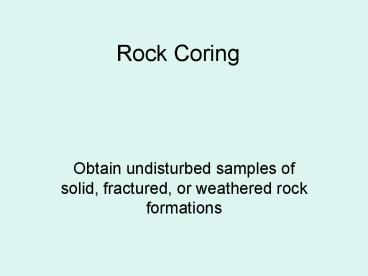Rock Coring - PowerPoint PPT Presentation
1 / 18
Title:
Rock Coring
Description:
Depth, core loss points, fractures. Borehole Logging. Written record of all field work ... Sample number and depth. Lengths of drives, pushes, or core runs ... – PowerPoint PPT presentation
Number of Views:500
Avg rating:3.0/5.0
Title: Rock Coring
1
Rock Coring
- Obtain undisturbed samples of solid, fractured,
or weathered rock formations
2
Purpose
- Exploration for structures
- Exploration for mineral deposits, rock quarries,
and structural studies - Test for load bearing capacity, hydraulic
conductivity, porosity, and mineral or chemical
content
3
Conventional Coring Systems
- Use a core barrel attached to the end of a drill
rod string - Rod string and core barrel assembly are removed
after each cutting run to recover the sample - The core barrel is emptied and returned to the
borehole for the next run
4
Wire-line Coring Systems
- More efficient that Conventional Coring Systems
- Use an outer barrel and a core casing
- An inner barrel can be lifted through the drill
string to the surface - The inner barrel is lifted to the surface with a
wire-line device, then lowered back in
5
Drilling Fluids
- Diamond or Carbide bits require cooling and
circulation fluids - Void spaces in formations can cause loss of fluid
circulation, indicated by loss of return fluid - Cuttings can accumulate in void spaces, resulting
in a loss of or damage to equipment - Filled void spaces affect borehole testing
6
Problems
- Rock mass surrounding borehole not
self-supporting - Protruding material in borehole
- Small diameter, vertical boreholes are generally
more stable - Friable sandstone and solution channeled
limestone or dolomite are more susceptible to
wall failure
7
Solutions
- High density drilling fluids plug fractures and
temporarily stabilize the borehole wall - Installing casing in the borehole and reducing
the size of the hole beneath the casing - Cement hole and redrill after the cement has
hardened
8
Minimizing Core Losses due to erosion of material
from fluid circulation
- Bit discharge directed away from core
- Drilling fluid use kept to a minimum
- Polymer compounds added to drilling fluid
- Vibration of drill rod minimized
- Controlled advancement of the drill rod
- Core-catching devices installed
9
Rock Core Logs
- To record all relevant information about the core
and to make a field description - Contains
- Percent core recovery
- Amount and location of core loss
- Depth of the beginning and ending of each core
run
10
Handling Procedures
- Properly label and identify all samples
- Sample packaging depends on sample types
- Samples for chemical analysis should remain
undisturbed, subsampled in the field and sealed
immediately - Chain of custody forms
11
Rock Core Samples
- Rigid container required for transport
- Core placed into box left to right like top to
bottom so it reads like a book - Mechanical breaks in core should be distinguished
from fractures - Core can be labeled on core surface
- Depth, core loss points, fractures
12
Borehole Logging
- Written record of all field work
- Prepared in the field
- Eventually converted to a final report log
13
Log Heading Information
- Project name and number
- Property location
- Surface elevation
- Surface conditions
- Type of drilling rig or pumping equipment
- Bit size and type
- Loggers name
- Borehole coordinates
14
Log Completion Information
- Should include the time and date that drilling
started - Time and date of completion
- Total depth drilled
- Total depth cased
- Abandonment procedures used, if any
- Final water level measurement
15
Sample Information
- Sampling method
- Number of blows required to advance split-barrel
sampler - Size and type of sampler
- Sample number and depth
- Lengths of drives, pushes, or core runs
- Length of recovered sample and percent of
recovery - Rock quality designation (RQD)
- Portion of the sample saved or submitted to lab
16
Soil and Rock Descriptions
- Sample description should be done in field
- Rock and Soil classification schemes are widely
studied and very important when classifying
samples - Knowledge of locality of sampling is very valuable
17
Drilling Information
- Records of drilling information should be made
for contract records, future site work, and cost
evaluation - Borehole logging form should have separate
drilling information and sample description
columns
18
Drilling Information
- Changes in penetration rate and drill rig
conditions - Mechanical performance and maintenance
- Conditions of circulation fluids and cuttings
- Penetration rate and bit pressure
- Changes in personnel































